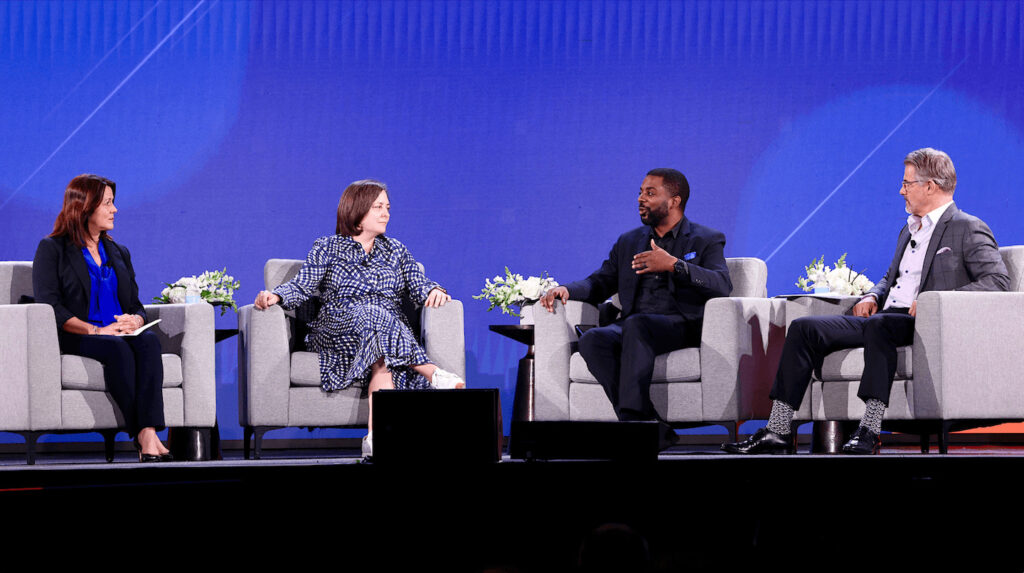
CHICAGO — The baby boomers will change the senior living industry dramatically and already are pushing it to a point of reckoning, according to a panel of experts discussing the next generation of 55-plus consumers.
Members of the Baby Boom generation currently are aged 58 to 77 years, so senior housing may be years off for many of them, if they become residents at all. But tomorrow’s consumer is looking for options, according to Helen Foster, principal at real estate development consultancy Foster Strategy and moderator of a panel at the 2023 National Investment Center for Seniors Housing & Care Fall Conference. Operators and developers need to look beyond the industry sector and feasibility studies for new sources of inspiration, she added. In short, Foster said, risk is imperative.
“We have to keep one foot in the known and one foot in the unknown, and we have to stand comfortably and firmly in that position,” Foster said, quoting a client. “It’s only in taking those risks that we have the chance to create something truly extraordinary.”
Foster said she sees great challenges, great change and great opportunity ahead for senior living, and the industry has reached a point where innovation is not a buzzword, but rather an imperative.
Senior living residents historically have been told when they can eat and what they can do. But Arrow Senior Living CEO Stephanie Harris, a panelist, said that that paradigm needs to change in light of the next generation of consumers. A cooperative business model can be created to solicit and use consumer feedback to determine the direction a business or community goes, she added.
“We’re going to be measured by the quality of our outcomes,” Harris said. “It’s not just a place to live in your final years; it’s a place to thrive in your final years.”
Another panelist, Rodney Harrell, PhD, vice president of family, home and community for the AARP, said that needed change starts with realizing that a wide variety of consumer preferences exists and that one size does not fit all. Nine out of 10 people aged 65 or more years want to age in place at home as long as possible, according to AARP studies, but only 1% of their homes have all the features people need to age well.
“People have preferences, and they change over time,” Harrell said. “We have to figure out how to meet these preferences and get past the barriers people face in terms of trying to achieve their preferences.”
Most people still are thinking about what they want their retirement to look like, Harris said. The oldest baby boomers are retiring or have retired, but they’re not moving into senior living communities. She said that since senior living is a need-driven product frequently triggered by an incident, it’s going to take a scare or a change to get someone to shift their thinking about what they need for the future.
The rise of active adult
Active adult is at the heart of the next-generation consumer, said panelist Brett Robinson, principal at Headwaters Consulting. The reality, he said, is that active adult communities are successfully attracting consumers at an average age of 72 who are looking for personalization of activities and lifestyles. The most important thing to the oldest baby boomers now considering senior housing, he said, is staying independent and self-sufficient.
“As we plan communities and programming and our customer value propositions, and the way that we convey what we’re all about, you have to have that mindset, even if it’s high acuity assisted living,” Robinson said.
The challenge, Foster said, is increasing receptivity to the 55-plus setting and educating consumers on the product. Terminology about the types of senior housing available is confusing — collectively, organizations can use the same term to mean several different things — so education and exposure to communities and their services is key.
Opportunity in middle market
The middle market, Harris said, is one of senior living’s biggest opportunities to attract incoming older baby boomers looking for an affordable option.
“The dynamic pricing model is going to be necessary even in new, targeted, higher-income markets,” she said. “You have to have a more dynamic model, and we have to figure out how to be more transparent in translating it easier to the consumer.”
Operators, Harris said, have to be more aggressive in communicating about the middle market affordable model and tying it to resources and amenities in the greater community. At the same time, she added, operators need to “meet people where they’re at” in their understanding of what the industry has to offer and be patient with them and help them understand the benefits of senior housing.
Inspiration outside the industry
The industry shouldn’t be afraid to consider other models, including buildings that house multiple generations, and take cues from the hospitality and wellness industries, Harrell said.
“A common thread between all best practices — the true innovators — is that they are looking outside for sources of inspiration,” Foster said. “It’s inspiration from the broader community and for the broader community.”
The Walt Disney Co.’s Storyliving and the Latitude Margaritaville communities, for example, are reshaping the industry because they have taken the stigma away from aging by focusing on food, fun, music, escapism and imagination, the panelists said.
“There is a mindset and focus on enjoying your life,” Robinson said. “We have to get ready for that and cater to those different tastes and styles with food, entertainment and things they are providing.”
The NIC Fall Conference ended Wednesday.


